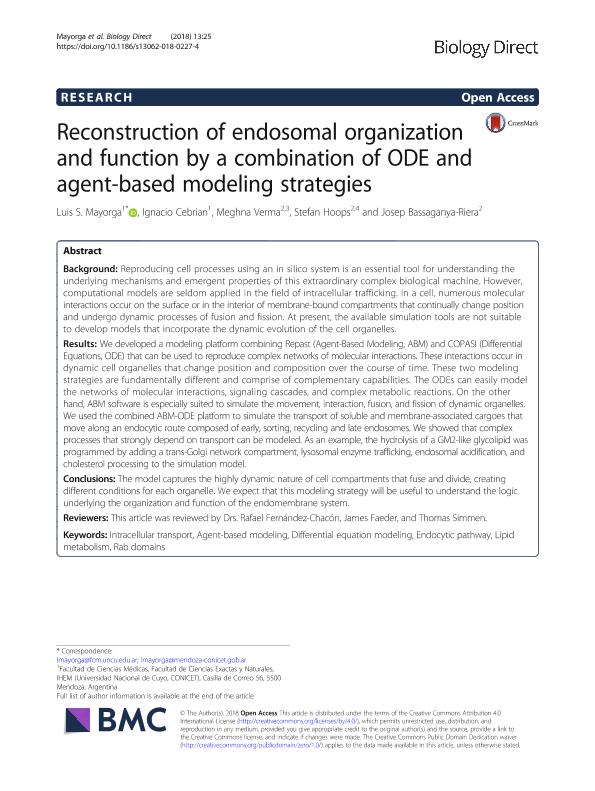Mostrar el registro sencillo del ítem
dc.contributor.author
Mayorga, Luis Segundo

dc.contributor.author
Cebrián, José Ignacio

dc.contributor.author
Verma, Meghna
dc.contributor.author
Hoops, Stefan
dc.contributor.author
Bassaganya-Riera, Josep
dc.date.available
2020-01-09T15:23:48Z
dc.date.issued
2018-11
dc.identifier.citation
Mayorga, Luis Segundo; Cebrián, José Ignacio; Verma, Meghna; Hoops, Stefan; Bassaganya-Riera, Josep; Reconstruction of endosomal organization and function by a combination of ODE and agent-based modeling strategies; BioMed Central; Biology Direct; 13; 1; 11-2018; 1-21
dc.identifier.issn
1745-6150
dc.identifier.uri
http://hdl.handle.net/11336/94123
dc.description.abstract
Background: Reproducing cell processes using an in silico system is an essential tool for understanding the underlying mechanisms and emergent properties of this extraordinary complex biological machine. However, computational models are seldom applied in the field of intracellular trafficking. In a cell, numerous molecular interactions occur on the surface or in the interior of membrane-bound compartments that continually change position and undergo dynamic processes of fusion and fission. At present, the available simulation tools are not suitable to develop models that incorporate the dynamic evolution of the cell organelles. Results: We developed a modeling platform combining Repast (Agent-Based Modeling, ABM) and COPASI (Differential Equations, ODE) that can be used to reproduce complex networks of molecular interactions. These interactions occur in dynamic cell organelles that change position and composition over the course of time. These two modeling strategies are fundamentally different and comprise of complementary capabilities. The ODEs can easily model the networks of molecular interactions, signaling cascades, and complex metabolic reactions. On the other hand, ABM software is especially suited to simulate the movement, interaction, fusion, and fission of dynamic organelles. We used the combined ABM-ODE platform to simulate the transport of soluble and membrane-associated cargoes that move along an endocytic route composed of early, sorting, recycling and late endosomes. We showed that complex processes that strongly depend on transport can be modeled. As an example, the hydrolysis of a GM2-like glycolipid was programmed by adding a trans-Golgi network compartment, lysosomal enzyme trafficking, endosomal acidification, and cholesterol processing to the simulation model. Conclusions: The model captures the highly dynamic nature of cell compartments that fuse and divide, creating different conditions for each organelle. We expect that this modeling strategy will be useful to understand the logic underlying the organization and function of the endomembrane system. Reviewers: This article was reviewed by Drs. Rafael Fernández-Chacón, James Faeder, and Thomas Simmen.
dc.format
application/pdf
dc.language.iso
eng
dc.publisher
BioMed Central

dc.rights
info:eu-repo/semantics/openAccess
dc.rights.uri
https://creativecommons.org/licenses/by-nc-sa/2.5/ar/
dc.subject
AGENT-BASED MODELING
dc.subject
DIFFERENTIAL EQUATION MODELING
dc.subject
ENDOCYTIC PATHWAY
dc.subject
INTRACELLULAR TRANSPORT
dc.subject
LIPID METABOLISM
dc.subject
RAB DOMAINS
dc.subject.classification
Otras Ciencias de la Computación e Información

dc.subject.classification
Ciencias de la Computación e Información

dc.subject.classification
CIENCIAS NATURALES Y EXACTAS

dc.subject.classification
Bioquímica y Biología Molecular

dc.subject.classification
Ciencias Biológicas

dc.subject.classification
CIENCIAS NATURALES Y EXACTAS

dc.title
Reconstruction of endosomal organization and function by a combination of ODE and agent-based modeling strategies
dc.type
info:eu-repo/semantics/article
dc.type
info:ar-repo/semantics/artículo
dc.type
info:eu-repo/semantics/publishedVersion
dc.date.updated
2019-10-23T19:30:22Z
dc.journal.volume
13
dc.journal.number
1
dc.journal.pagination
1-21
dc.journal.pais
Reino Unido

dc.journal.ciudad
Londres
dc.description.fil
Fil: Mayorga, Luis Segundo. Consejo Nacional de Investigaciones Científicas y Técnicas. Centro Científico Tecnológico Conicet - Mendoza. Instituto de Histología y Embriología de Mendoza Dr. Mario H. Burgos. Universidad Nacional de Cuyo. Facultad de Ciencias Médicas. Instituto de Histología y Embriología de Mendoza Dr. Mario H. Burgos; Argentina
dc.description.fil
Fil: Cebrián, José Ignacio. Consejo Nacional de Investigaciones Científicas y Técnicas. Centro Científico Tecnológico Conicet - Mendoza. Instituto de Histología y Embriología de Mendoza Dr. Mario H. Burgos. Universidad Nacional de Cuyo. Facultad de Ciencias Médicas. Instituto de Histología y Embriología de Mendoza Dr. Mario H. Burgos; Argentina
dc.description.fil
Fil: Verma, Meghna. Biocomplexity Institute; Estados Unidos. Virginia Polytechnic Institute And State University;
dc.description.fil
Fil: Hoops, Stefan. University of Virginia; Estados Unidos. Biocomplexity Institute; Estados Unidos
dc.description.fil
Fil: Bassaganya-Riera, Josep. Biocomplexity Institute; Estados Unidos
dc.journal.title
Biology Direct

dc.relation.alternativeid
info:eu-repo/semantics/altIdentifier/doi/http://dx.doi.org/10.1186/s13062-018-0227-4
dc.relation.alternativeid
info:eu-repo/semantics/altIdentifier/url/https://biologydirect.biomedcentral.com/articles/10.1186/s13062-018-0227-4
Archivos asociados
